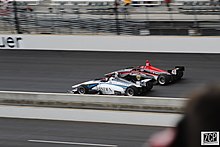Indy NXT
The Indy Lights champion was awarded a $1M scholarship toward the IndyCar Series, and guaranteed three races including the Indianapolis 500 during this time.
In the post-WWII era, through the early 1960s, American open-wheel racing cars were almost exclusively front-engined "roadsters".
When United States Automobile Club (USAC) became the primary sanctioning body for top-level open-wheel racing, the ladder of progression began to change.
Following the end of the "Mini Indy" series, the driver pool in the early 1980s for CART and the Indy 500 was drawn in a somewhat unorganized fashion among Super Vees, Atlantics, former Can-Am drivers, sprint cars, midgets, and even stock cars and off-road racing.
CART became the sanctioning body for the series in 1988, and it was renamed as Indy Lights in 1991, with title sponsorship by Firestone.
In some rare occasions, the Indy Lights ran at non-CART tracks, generally as a support race to a series other than CART.
In addition, the Atlantics served as a springboard for such drivers as Greg Ray, Sam Hornish Jr. and Richie Hearn to enter the IRL.
It was a spec series using a TWR (Tom Walkinshaw Racing) developed 3.5L version of the V8 engine used in the Infiniti Q45 combined with Dallara chassis producing 420 horsepower (310 kW).
In 2006, a boost in prize money even further increased car counts to 16 or more, with an even six oval and six road course mix.
On March 26, 2008, the series announced a changing of names, when the historical records and proprietary information of Champ Car were acquired by the IRL.
On September 9, 2007, during the Chicagoland 100, Logan Gomez beat Alex Lloyd by 0.0005 seconds (approximately 1.65 inches (42 mm) at 188 mph) which reflects what was the closest recognized finish in the over century-long history of organized automobile racing throughout the world, until the 2018 Powershares QQQ 300.
[5] This resulted in all three levels of the Road to Indy leading up to the IndyCar Series being promoted by Andersen and feature Cooper tires, beginning in 2014.
[6] On November 1, 2013 a new logo was unveiled for the Indy Lights series[7] On November 26 it was announced that the engine for the new package would be a 2.0L turbocharged MZR-R four cylinder engine, tuned to last a full season of competition and producing 450 horsepower, with push-to-pass offering an additional 50 horsepower.





